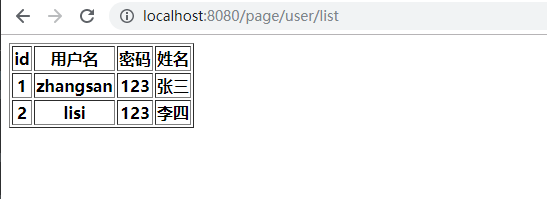目录结构

第一步:在pom.xml文件中添加依赖
<!--模板依赖-->
<dependency>
<groupId>org.springframework.boot</groupId>
<artifactId>spring-boot-starter-freemarker</artifactId>
</dependency>
<!-- springBoot JPA的起步依赖 -->
<dependency>
<groupId>org.springframework.boot</groupId>
<artifactId>spring-boot-starter-data-jpa</artifactId>
</dependency>
<dependency>
<groupId>mysql</groupId>
<artifactId>mysql-connector-java</artifactId>
</dependency>
第二步:在application.properties中配置数据源
#DB Configation spring.datasource.driver-class-name=com.mysql.jdbc.Driver spring.datasource.url=jdbc:mysql://127.0.0.1:3306/springboot?serverTimezone=UTC spring.datasource.username=root spring.datasource.password=root #JPAConfiguration spring.jpa.database=MySQL spring.jpa.show-sql=true spring.jpa.generate-ddl=true
注意:需提前创建好数据库
第三步:在resources/templates 目录下 创建freemarker模板文件 文件格式:文件后缀名.ftl
用于接收数据
<html>
<head>
<title>spring boot</title>
</head>
<body>
<table border="1px">
<thead>
<tr>
<th>id</th>
<th>用户名</th>
<th>密码</th>
<th>姓名</th>
</tr>
</thead>
<tbody>
<#list userList as user>
<tr>
<th>${user.id}</th>
<th>${user.username}</th>
<th>${user.password}</th>
<th>${user.name}</th>
</tr>
</#list>
</tbody>
</table>
</body>
</html>
第四步:创建实体类
import javax.persistence.*;
@Entity
@Table(name="user")
public class User {
@Id
@GeneratedValue(strategy = GenerationType.IDENTITY)
private int id;
private String username;
private String password;
private String name;
public int getId() {
return id;
}
public void setId(int id) {
this.id = id;
}
public String getUsername() {
return username;
}
public void setUsername(String username) {
this.username = username;
}
public String getPassword() {
return password;
}
public void setPassword(String password) {
this.password = password;
}
public String getName() {
return name;
}
public void setName(String name) {
this.name = name;
}
@Override
public String toString() {
return "User{" +
"id=" + id +
", username='" + username + '\'' +
", password='" + password + '\'' +
", name='" + name + '\'' +
'}';
}
}
第五步:在dao层创建一个接口
import org.springframework.data.jpa.repository.JpaRepository;
public interface UserDao extends JpaRepository<User,Integer> {
}
第六步:创建controller层用于给.ftl文件传递数据
import org.springframework.beans.factory.annotation.Autowired;
import org.springframework.beans.factory.annotation.Value;
import org.springframework.stereotype.Controller;
import org.springframework.ui.Model;
import org.springframework.web.bind.annotation.RequestMapping;
import org.springframework.web.bind.annotation.ResponseBody;
import java.util.HashMap;
import java.util.List;
import java.util.Map;
@Controller
public class PageController {
@Autowired
private UserDao userDao;
@RequestMapping("/page/user/list")
public String showUserList(Model model){
List<User> userList=userDao.findAll();
model.addAttribute("userList",userList);
return "user";
}
}
第七步:启动项目,访问地址 http://localhost:8080/page/user/list
